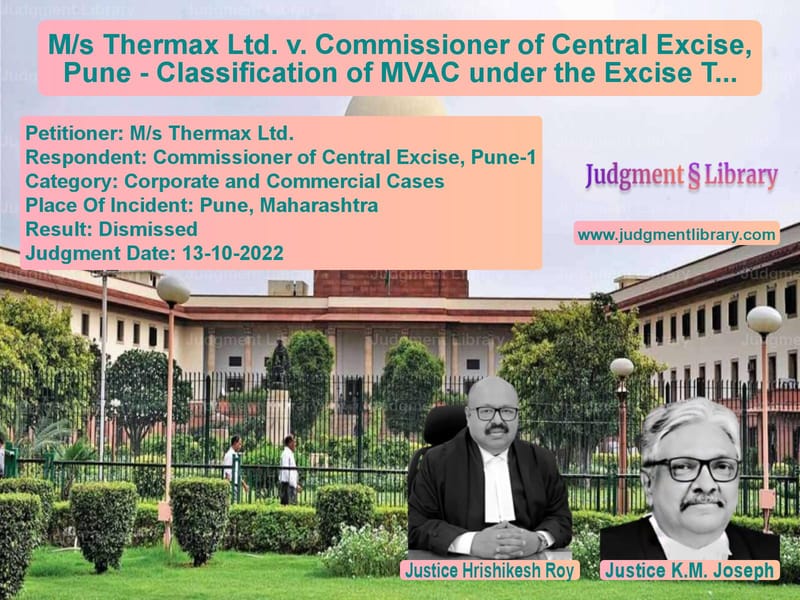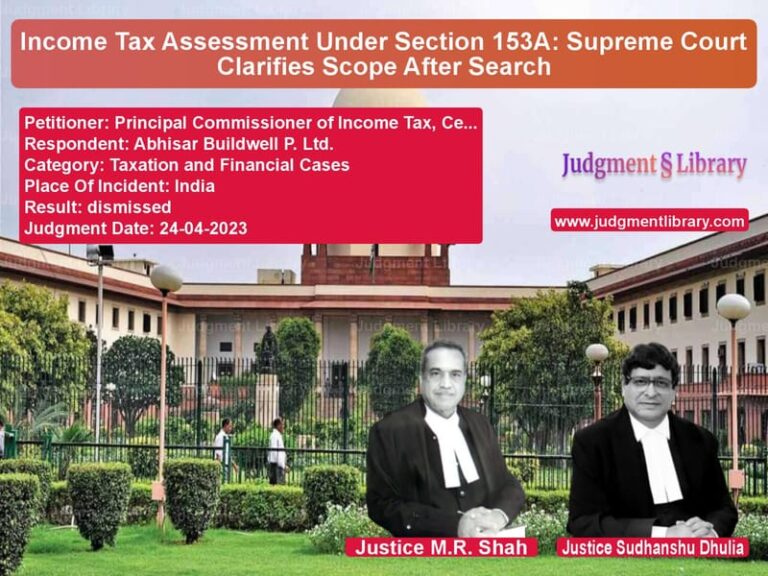M/s Thermax Ltd. v. Commissioner of Central Excise, Pune – Classification of MVAC under the Excise Tariff
This case pertains to the classification of Modified Vapour Absorption Chillers (MVAC) manufactured by M/s Thermax Ltd., and whether they qualify as heat pumps for the purpose of availing concessional excise duty under Notification No. 155/86-CE. The primary issue was whether the MVAC, capable of producing both chilled and hot water, should be classified as a heat pump under heading 8418, or as a refrigerator, which attracts a higher duty. The appellant, Thermax Ltd., challenged the CESTAT’s decision that denied the classification of the MVAC as a heat pump and disallowed the concessional excise duty.
Petitioner and Respondent Arguments
Petitioner’s Arguments:
- The petitioner, M/s Thermax Ltd., argued that their MVAC machine, by virtue of its design and modification, functions as a heat pump. It was emphasized that the MVAC can provide both chilled and hot water, which is a defining feature of heat pumps. The appellant contended that the inclusion of additional components such as sensors, selector switches, and additional wiring to control the heating and cooling modes made the MVAC a modified heat pump.
- The appellant also cited technical books and self-prepared charts to demonstrate that the MVAC operates on the principle of heat absorption and energy transformation, akin to heat pumps. The appellant argued that the classification should be based on the machine’s function as a whole and its capability to produce both hot and cold water.
- The appellant further referenced similar products from Blue Star and Voltas, which were classified as heat pumps under the same tariff heading, claiming that a similar approach should be applied to their product, given that the machine’s intended use and operation were comparable.
Respondent’s Arguments:
- The respondent, the Revenue, disagreed with the classification of MVAC as a heat pump. It was contended that according to the Harmonised System of Nomenclature (HSN), heat pumps are specifically designed to absorb heat and produce a more intense heat source, which was not the primary function of the MVAC. The Revenue argued that the main function of the MVAC was to produce chilled water, and the production of hot water was incidental and not sufficient to classify it as a heat pump.
- The respondent pointed out that the HSN definition of heat pumps clearly requires that the device draws heat and converts it into a more intense heat source, a characteristic that MVAC did not meet. The Revenue also emphasized that in the market, the product was recognized as a vapour absorption chiller and not as a heat pump, with customers primarily purchasing it for cooling purposes.
- Furthermore, the Revenue argued that applying the HSN definition strictly was necessary, as the excise tariff classification should align with international standards, and deviations based on marketing terminology would be improper.
Key Issues and Supreme Court’s Ruling
The Supreme Court addressed the following major issues in this case:
1. Classification of MVAC as a Heat Pump
The Supreme Court considered whether MVAC could be classified as a heat pump under the HSN. The Court referred to the definition of heat pumps in the HSN, which specifies that a heat pump is a device that draws heat from a suitable source and converts it into a more intense heat source. The Court found that while MVAC has the capacity to generate hot water, this function was incidental to its primary role of producing chilled water.
The Court also observed that the appellant had not demonstrated that the primary function of the MVAC was heating, as it was marketed and recognized in the industry as a chiller. The Court therefore upheld the CESTAT’s finding that MVAC should not be classified as a heat pump, as it did not meet the HSN definition.
2. Application of the Harmonised System of Nomenclature (HSN)
The Court emphasized the importance of the HSN definition in classifying products for the purpose of excise duty. It pointed out that the Indian Central Excise Tariff was based on the HSN, and that classification disputes should be resolved with reference to the HSN definitions unless there is a specific provision in Indian law to the contrary. The Court referred to previous judgments where the HSN definitions had been upheld and used to resolve classification issues.
3. Market and Popular Understanding of MVAC
The Court noted that the market parlance test also supported the classification of MVAC as a vapour absorption chiller rather than a heat pump. The product was recognized in the market primarily for its cooling function, and customers purchased it for its ability to produce chilled water, not for the incidental production of hot water. The Court concluded that the MVAC did not qualify as a heat pump based on its primary use in the market.
Conclusion
The Supreme Court dismissed the appeal filed by M/s Thermax Ltd. and upheld the decision of the CESTAT. The Court ruled that the MVAC manufactured by the appellant should be classified as a vapour absorption chiller and not as a heat pump. The Court emphasized that the HSN definition of heat pumps should be followed strictly, and that the primary function of the MVAC was cooling, with the production of hot water being incidental.
The Court’s decision underscores the importance of following international classification standards and ensuring that products are classified based on their primary function and market use. The ruling also clarifies the application of the HSN in the context of the Central Excise Tariff Act, 1985.
Impact and Implications
This judgment has significant implications for the classification of products under the Indian Central Excise Tariff. It reinforces the importance of the HSN definitions in determining the correct tariff classification and the need to classify products based on their primary function. The ruling also highlights the need for businesses to ensure that their products are marketed in line with their intended use, as the market parlance test can influence the classification of goods for excise purposes.
Petitioner Name: M/s Thermax Ltd..Respondent Name: Commissioner of Central Excise, Pune-1.Judgment By: Justice Hrishikesh Roy, Justice K.M. Joseph.Place Of Incident: Pune, Maharashtra.Judgment Date: 13-10-2022.
Don’t miss out on the full details! Download the complete judgment in PDF format below and gain valuable insights instantly!
Download Judgment: ms-thermax-ltd.-vs-commissioner-of-cent-supreme-court-of-india-judgment-dated-13-10-2022.pdf
Directly Download Judgment: Directly download this Judgment
See all petitions in Company Law
See all petitions in Corporate Governance
See all petitions in unfair trade practices
See all petitions in Bankruptcy and Insolvency
See all petitions in Judgment by Hrishikesh Roy
See all petitions in Judgment by K.M. Joseph
See all petitions in dismissed
See all petitions in supreme court of India judgments October 2022
See all petitions in 2022 judgments
See all posts in Corporate and Commercial Cases Category
See all allowed petitions in Corporate and Commercial Cases Category
See all Dismissed petitions in Corporate and Commercial Cases Category
See all partially allowed petitions in Corporate and Commercial Cases Category







